Speedy Web Design from Xara Web Designer MX
I just created an 8-page website design in less than 5 minutes and all but about 2 seconds of that time was occupied by trying to decide which of the 41 templates I wanted to use. Creating the pages required, literally, no more than double-clicking the website template option. There's more to creating a website than selecting a template, of course: You'll need to add your own words and illustrations but if you're good with words, not so good with design, and completely flummoxed by HTML, Javascript, and the like, Xara Web Designer MX will let you look like a pro.
Let me take you on a short tour that explains how easy it is to build a website with Xara Web Designer MX Premium—and not just any website but one that's attractive and responsive.
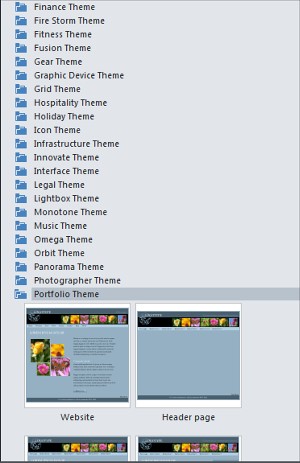 I started by examining the impressive list of included themes and selected one called Portfolio.
I started by examining the impressive list of included themes and selected one called Portfolio.
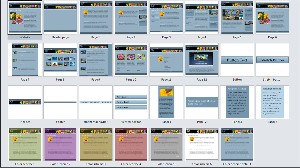 The theme offers 12 page types, buttons, header and footer elements, vertical and horizontal navigation bars, insertable panels, and 7 color schemes. Although I could build the site one page at a time, the fastest way to create the site is just to select the Website option.
The theme offers 12 page types, buttons, header and footer elements, vertical and horizontal navigation bars, insertable panels, and 7 color schemes. Although I could build the site one page at a time, the fastest way to create the site is just to select the Website option.
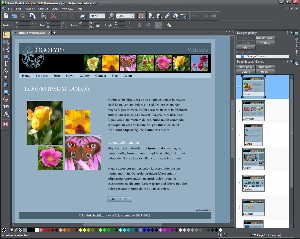 That gave me an 8-page starter site. I can move from page to page by selecting the page I want to edit in the panel at the right. The menu links are already set up and operational. Of course, I may want to add or remove links, but that's easy enough to do.
That gave me an 8-page starter site. I can move from page to page by selecting the page I want to edit in the panel at the right. The menu links are already set up and operational. Of course, I may want to add or remove links, but that's easy enough to do.
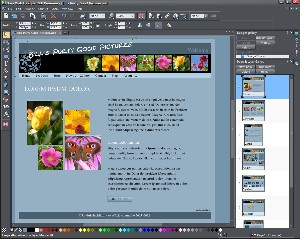 I would like something other than the word "LOGOTYPE" at the top of the page. Double-clicking the word, I typed "Bill's Purty Good Pictures" and now, you're thinking, he'll have to do that on the other 7 pages. But no. This is a repeating object so changing it on one page changes it on all pages.
I would like something other than the word "LOGOTYPE" at the top of the page. Double-clicking the word, I typed "Bill's Purty Good Pictures" and now, you're thinking, he'll have to do that on the other 7 pages. But no. This is a repeating object so changing it on one page changes it on all pages.
At the same time, I changed the typeface and, just for fun, rotated the graphic and the text. These changes are also replicated on all other pages.
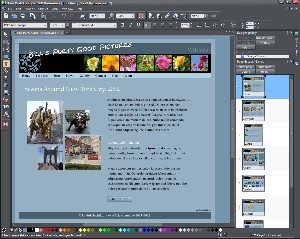 Then it was time to change some of the pictures on the page. The pictures I selected were BMP images instead of JPGs and Xara Web Designer suggested that I should allow it to convert the images to JPG for the Web. The photos appeared with handles that allowed me to size, rotate, and move them within the frames. It's also possible to change the frame sizes.
Then it was time to change some of the pictures on the page. The pictures I selected were BMP images instead of JPGs and Xara Web Designer suggested that I should allow it to convert the images to JPG for the Web. The photos appeared with handles that allowed me to size, rotate, and move them within the frames. It's also possible to change the frame sizes.
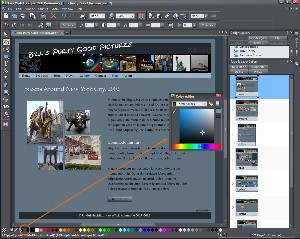 You may be wondering about the images at the top. These are in the title area, so will changes made on this page be replicated elsewhere? In this case, the answer is no. These images could be linked to the other pages but by default, this template doesn't link them. Most users would probably prefer that these images be linked but I can also see interesting possibilities that could come from using different images on each page in the site.
You may be wondering about the images at the top. These are in the title area, so will changes made on this page be replicated elsewhere? In this case, the answer is no. These images could be linked to the other pages but by default, this template doesn't link them. Most users would probably prefer that these images be linked but I can also see interesting possibilities that could come from using different images on each page in the site.
For the most part, development continues that way in this application. When you want to do something, you just do it. If I'd like the theme's background color to be darker and more neutral, making the change requires only selecting the theme color swatch and editing in the pop-up color editor. The change is automatically previewed on the page. And, yes, this applies across the entire site on any page and in any object where the color is used.
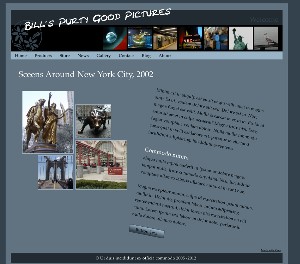 Xara includes support for building Flash animations as well as for page and layer transition effects (changing photographs on click or mouse-over for example).
Xara includes support for building Flash animations as well as for page and layer transition effects (changing photographs on click or mouse-over for example).
One thing that is different from most other website development programs is Xara's ability to rotate text. You already saw that in the banner's logo but you can achieve the same effect with standard text. One thing to bear in mind if you rotate text, though, is that it will be converted to a graphic because HTML doesn't yet provide the ability to display rotated text. Xara Web Designer attempts to help, though, by placing all of the text inside "alt" tags so that search engines will see it.
Xara has a long background in graphics applications and because of that you'll find several thousand items in the Design Gallery—clip art, buttons, icons, and even some photos.
Should you decide that you don't care for any of the more than 3 dozen templates, each with a variety of color themes, you can start with a blank page and build your own template.
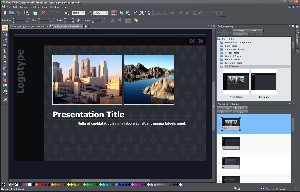 Xara offers Web Designer in two versions: Standard and Premium. The Premium version includes a new feature called Presentations. Although just a few presentation themes exist (13, plus a section that contains presentation components) they are all attractive and easy to use. You won't be surprised to find that customizing these is as easy as modifying the website templates.
Xara offers Web Designer in two versions: Standard and Premium. The Premium version includes a new feature called Presentations. Although just a few presentation themes exist (13, plus a section that contains presentation components) they are all attractive and easy to use. You won't be surprised to find that customizing these is as easy as modifying the website templates.
When you're finished, instead of a standard website, you have a slide show.
Web Designer includes the ability to use more than just the few standard "Web safe" typefaces in the websites you create but the support is still incomplete in that it doesn't support Microsoft's WOFF format or the lesser-used SVG format so browser support is limited.. You can create interactive charts and graphs that respond to mouse movements. The list, which is already quite impressive, goes on and on.
You can download the program and use it for free (with a limited number of templates) for 7 days and, if you register the free trial, the trial period extends to 30 days. The Premium version sells for $100 and the Standard version for $50.

 As Usual, Xara Offers More Features than Expected for Less Cost than Anticipated
As Usual, Xara Offers More Features than Expected for Less Cost than Anticipated
You won't find more website development power for less money anywhere. Even the $50 standard version offers a lot but the premium version really shines. For more information, visit the Xara Web Designer MX website.
Slim Browser Puts IE on a Diet
An acquaintance recently asked about Slim Browser. Although I'd never heard of it, the browser has been around for a while. It's based on the Trident layout engine. The person who told be about Slim Browser detests Microsoft's Internet Explorer and that made the recommendation humorous.
The Trident layout engine is what runs Microsoft Internet Explorer so Slim Browser is really just a front end for IE. It adds some new features that Internet Explorer doesn't have but it's still IE under the hood so if you're a registered, card-carrying, Microsoft hater, this won't be the browser for you.
Surprising (and Sometimes Amusing) Features
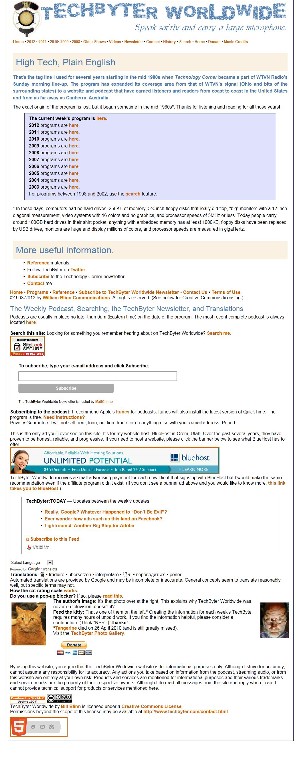 Here's an amusing feature: Press Ctrl and the tilde key (~) to make the browser disappear. The browser vanishes and its icon on the Task Bar dims, indicating that the browser isn't open. One tell-tale sign that you've done this is that if you click the icon in the Task Bar to open the browser, nothing happens.
Here's an amusing feature: Press Ctrl and the tilde key (~) to make the browser disappear. The browser vanishes and its icon on the Task Bar dims, indicating that the browser isn't open. One tell-tale sign that you've done this is that if you click the icon in the Task Bar to open the browser, nothing happens.
How about a highly useful feature? Sometimes you'd like to grab a screen shot of an entire browser page—everything, not just what you can see on the screen. This is a built-in Slim Browser function.
Slim Browser is a tabbed browser, as are most browsers these days. When you have several tabs open, you can close an individual tab, close all tabs to the left or right of the current tab, close all tabs, close all but the current tab, or close all and start a new session. Oops! You didn't mean to do that? Slim Browser teases you with an "Undo Last Close All" menu item but it really just reopens the last tab you closed. Clever idea but no prize for execution.
What happens in most browsers when you type a new URL into the address bar where a site is already open? The tab you're in switches to the new site. In Slim Browser, something else happens: A new tab opens and that tab goes to the new site. The previous site stays open. I happen to like this a lot but if you don't, you can change the behavior.
Plug-ins that work with Internet Explorer will work with Slim Browser and if you don't care for browser's appearance, you can download a new skin.
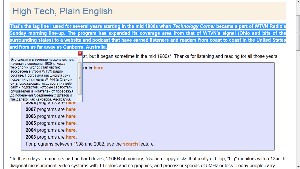 Website translations are common these days. Slim Browser has a built-in function that offers translations. Google and Bing translate sites but Slim Browser has the hooks built in. Translate an entire page or just some selected text. The translation engine Slim Browser uses can be either Bing's or Google's.
Website translations are common these days. Slim Browser has a built-in function that offers translations. Google and Bing translate sites but Slim Browser has the hooks built in. Translate an entire page or just some selected text. The translation engine Slim Browser uses can be either Bing's or Google's.
The Tools menu is where you'll find many of the most useful functions: Direct links to Facebook and other services such as Google Plus, Twitter, StumbleUpon, Blogger, WordPress, Gmail, Hotmail, and Yahoo mail. You'll also find a pop-up blocker and an ad blocker here, settings for privacy and proxies, and possibly my favorite, Alias Definitions.
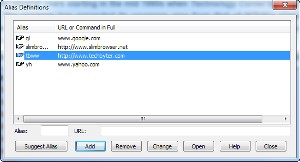 The Alias feature (if you're a Linux maven, you already know where this is going) makes it possible to type a short alias (tbww, for example) instead of the full URL (www.techbyter.com). Type the alias in the address bar and hit Enter; you're there.
The Alias feature (if you're a Linux maven, you already know where this is going) makes it possible to type a short alias (tbww, for example) instead of the full URL (www.techbyter.com). Type the alias in the address bar and hit Enter; you're there.
 And finally, another fun feature: When you visit a website, the browser's title bar shows the information that the the site returns inside a title tag. This information is repeated on the tab. If you want something else to appear, you can change the assigned site name. This can be a useful feature. In a corporate environment, where you might have several tabs open to different sections of the same site, you could define tabs for Payroll, Directory, and Project Codes.
And finally, another fun feature: When you visit a website, the browser's title bar shows the information that the the site returns inside a title tag. This information is repeated on the tab. If you want something else to appear, you can change the assigned site name. This can be a useful feature. In a corporate environment, where you might have several tabs open to different sections of the same site, you could define tabs for Payroll, Directory, and Project Codes.
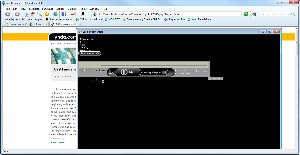 Unfortunately, Slim Browser doesn't work very well with services such as Lynda.com. There's probably a way to make it work but the point is that for a service as popular as this teaching site, it should just work. Here's Lynda.com on Slim Browser.
Unfortunately, Slim Browser doesn't work very well with services such as Lynda.com. There's probably a way to make it work but the point is that for a service as popular as this teaching site, it should just work. Here's Lynda.com on Slim Browser.

 Slim Browser is Solid and Lives Up to its Name
Slim Browser is Solid and Lives Up to its Name
This product of Austin, Texas, adds some useful features to Internet Explorer and there's a lot to like but it's hobbled by reliance on IE's limited set of plug-ins when compared to Google's Chrome and particularly to Mozilla's resource-hogging Firefox.
For more information, visit the Slim Browser website.
Short Circuits
One for Google. One for Oracle.
If the court fight between Google and Oracle over software copyrights was a baseball game, it would be a double-header or maybe a series. The double-header is over with Google taking one game and Oracle the other. But the series will continue. Oracle, the company that acquired Sun Microsystems and, with it, the Java programming language says that Google improperly used Java code in developing its Android operating system.
This week's decision means that the Android operating system won't have to be rewritten and that is a huge win for Google and possibly bad news for Microsoft, whose upcoming Windows 8 operating system has support for tablets. Forcing a rewrite could have been a disaster for Google because its operating system runs on something like 300 million smart phones around the world.
But Google was found guilty of copyright violations. The jury was clearly unconvinced by either side and apparently confused about copyright law. Although Google violated Oracle’s copyright, the jury said, it couldn't conclusively say whether the violation fell within the "fair use" provision of copyright law. [I am not a lawyer but it seems to me that if "fair use" applies, there was no violation.] One of Google's lawyers said the company would ask for a mistrial because "fair use" and "violation" are different sides of the same coin.
The victory for Oracle will result in some cash payments from Google but probably not enough to make much difference to either company. Their lawyers probably charged more for lunches during the trial. But Oracle can now attempt to force Google to license the software, something that Google doesn't want to do because of the control it would give Oracle.
[Does this seem more than a little convoluted to you? Yeah, me too.]
Oracle says that Google improperly used what are called application programming interfaces (API) but Google maintains that APIs cannot be copyrighted because they are tools that programmers use to build applications. Whether they might be patentable is another question and one that will be heard in another trial. With the copyright phase of the litigation done, at least for now, the two sides move on to arguing about software patents.
One of the confusing parts of this case centers around the fact that Java is open-source code. Even so, many users of Java licensed their use of the programming language from Sun Microsystems. Google didn't and says that it can use Java freely and without restriction just as people like me use the English language to write articles such as this.
Angry Birds are Finish(ed)
The Särkänniemi (SARK-en-ya-me) theme park in Finland now has an area for Angry Birds. Angry Bird Land builds on the Rovio game that's on just about everyone's smart phone and on lots of tablets, Angry Birds. The theme park area features 12 rides, what's called an adventure area, games, and food courts.
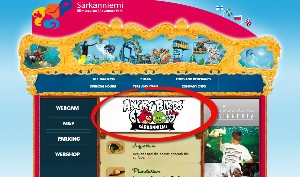 See for yourself here.
See for yourself here.
Meanwhile, back in the United States, Rovio reported revenues of just over $106 million in 2011. Not bad for a bunch of rotund birds that explode and blow up evil pigs. Seriously, if somebody had come to you with an idea for a game that involves cartoon birds propelled by slingshots at evil pigs, would you have bought the idea?
Rovio's pre-tax earnings for the year were just under $68 million.
At the end of the year, total Angry Birds downloads had reached 648 million, with about 200 million active monthly users. There are rumors that the company will try to go public soon but there are also questions about Rovio's long-term potential. So far, it has exactly one product, Angry Birds. Games such as these eventually go stale and if there's nothing new in the hopper, the company doesn't have much of a future.
But there's at least talk of new games. In the 2011 earnings statement, Rovio discussed new games and initiatives for 2012. Now, a third of the way through the year, there's only the theme park in Finland and reports of talks aimed at developing toys based on Angry Birds. And still nothing new on the horizon as far as games go.
Finding Stuff Just Got Easier
Some things are easier to find than others. Cell phones, for example. If you forget where you left it, you can just call it and the ring will tell you where it is. Keys are a different matter, though. Leave them where you know you'll be able to remember and you won't. Then there's that unproductive and frustrating search.
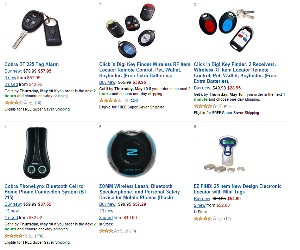 Some clever inventors feel our pain and now you can add a a key finder to your key chain. Attach it to your keys (it's about the size of a standard key fob) and you can activate it with an app on your Bluetooth-enabled phone. There are three problems, though: You need a Bluetooth-enabled cell phone (mine isn't), you need not to have lost your phone at the same time you've lost your keys, and the device costs $60. If you don't have a Bluetooth device, there are other options.
Some clever inventors feel our pain and now you can add a a key finder to your key chain. Attach it to your keys (it's about the size of a standard key fob) and you can activate it with an app on your Bluetooth-enabled phone. There are three problems, though: You need a Bluetooth-enabled cell phone (mine isn't), you need not to have lost your phone at the same time you've lost your keys, and the device costs $60. If you don't have a Bluetooth device, there are other options.
Maybe it would be easier to just install a key hook and always remember to put your keys there. I have one of these at the office but not at home so I've never lost my keys at the office but I'm constantly misplacing them at home. Maybe there's a lesson there.
What I'd really like is something that would help me find things like wallets and card cases. I've been searching for a card case for the past week but most devices such as these are too bulky for card cases or wallets.
The Bluetooth device is called Cobra BT Tag (upper left corner). Other devices such as the Click 'n Dig units depend on a "calling" device and and "answering" device. Place the answering device on the things you want to find and carry the calling device around with you. Maybe those with Bluetooth phones could attach a Cobra BT Tag to a Click 'n Dig calling device so that when they lost the calling device they could use their phone to find it. Assuming that they can find their phone.
Amazon Learns Some New Tricks
More than anything else, "Amazon" brings books to mind. Amazon sells much more than books but that's where they started. The company sells its own hardware, the Kindle reader and the Fire tablet, but lately they seem to have branched out into other hardware.
Despite the fact that my primary desktop computer has something like 8 USB ports and a 4-port hub that effectively adds 3 more ports, the addition of yet another USB device made the addition of even more ports a reasonable idea.
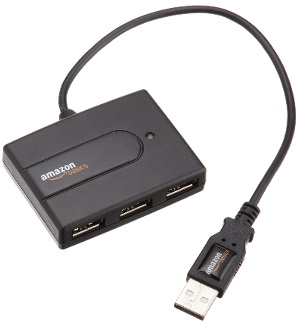 In looking for hubs, I found an Amazon Basics USB 2.0 4-port hub for $9.15 with free shipping. You'll find prices vary a lot for USB hubs. I found a powered 4-port hub for $140, others (including a Darth Vader hub) for around $40, dozens of models in the $15 to $20 range, and even some for $2 or $3.
In looking for hubs, I found an Amazon Basics USB 2.0 4-port hub for $9.15 with free shipping. You'll find prices vary a lot for USB hubs. I found a powered 4-port hub for $140, others (including a Darth Vader hub) for around $40, dozens of models in the $15 to $20 range, and even some for $2 or $3.
In part this price variance is because some hubs are powered and some are not. The computer provides 5 volts via USB to attached devices. Many USB devices don't need power and can be attached to a non-powered hub but devices such as printers and some scanners do need power, hence the availability of some USB hubs with attached power adapters.
I didn't need a powered hub—just a basic 4-port hub. I didn't need Darth Vader. And I was a bit suspicious of hubs priced at $2. But a basic hub, sold by Amazon, with Amazon's name on it—well, that seemed reasonable.
When it arrived a day or two later, I plugged it in and attached some devices. And that's it. Sometimes simple stories are best.
A Special Treat This Week
Maybe you've wondered how techies figure out what's wrong when you call them with a problem. I can't guarantee that the flow chart shown below is totally accurate but it's distressingly close. The XKCD comic is one of my favorites, a mixture (as the artist says) of romance, sarcasm, math, and language.
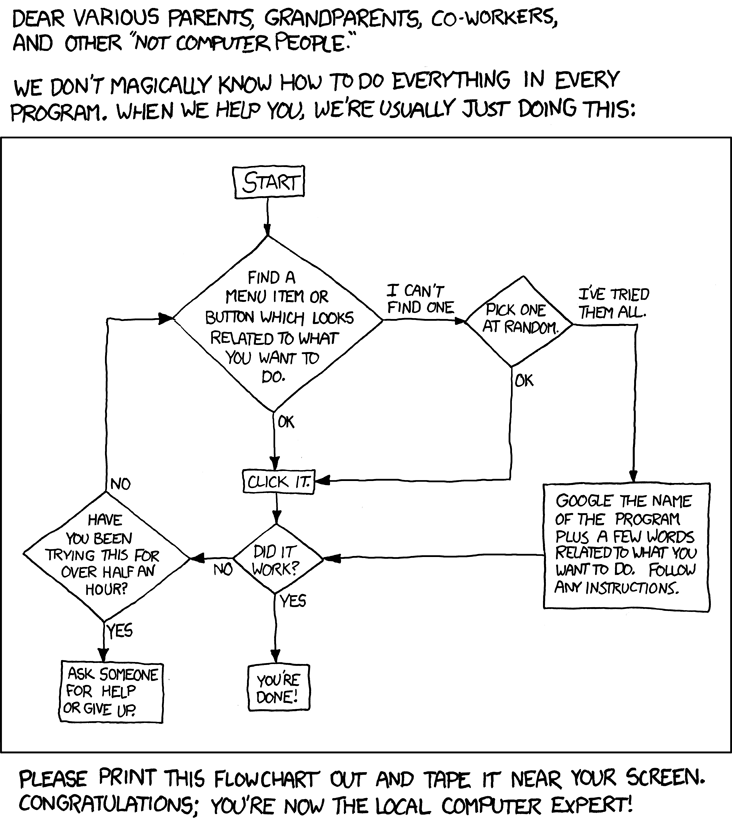

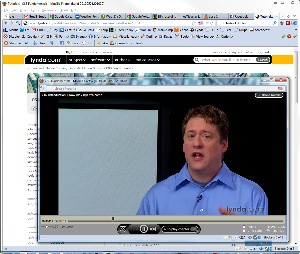


 The author's image: It's that photo over at the right. This explains why TechByter Worldwide was never on television, doesn't it?
The author's image: It's that photo over at the right. This explains why TechByter Worldwide was never on television, doesn't it?
